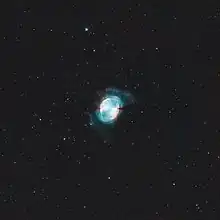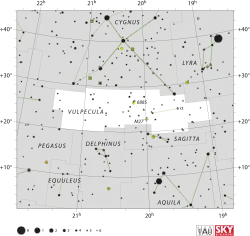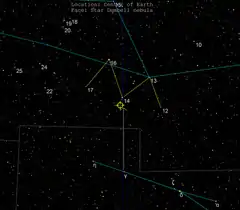| Emission nebula | |
|---|---|
| Planetary nebula | |
 Dumbbell Nebula (Messier 27) in Vulpecula | |
| Observation data: J2000 epoch | |
| Right ascension | 19h 59m 36.319s[1] |
| Declination | +22° 43′ 16.312″[1] |
| Distance | 389+15 −6[1] pc |
| Apparent magnitude (V) | 7.4[2] |
| Apparent dimensions (V) | 8.0′ × 5.6′[3] |
| Constellation | Vulpecula |
| Physical characteristics | |
| Radius | 1.44+0.21 −0.16[a] ly |
| Absolute magnitude (V) | −0.6+0.4 −0.3[d] |
| Notable features | Central star radius is among the largest known for a white dwarf. |
| Designations | NGC 6853,[1] M 27,[1] Diabolo Nebula,[1] Dumb-Bell Nebula,[1] |
The Dumbbell Nebula (also known as the Apple Core Nebula, Messier 27, and NGC 6853) is a planetary nebula (nebulosity surrounding a white dwarf) in the constellation Vulpecula, at a distance of about 1360 light-years.[1] It was the first such nebula to be discovered, by Charles Messier in 1764. At its brightness of visual magnitude 7.5 and diameter of about 8 arcminutes, it is easily visible in binoculars[4] and is a popular observing target in amateur telescopes.
Shape and size
The Dumbbell Nebula appears shaped like a prolate spheroid and is viewed from our perspective along the plane of its equator. In 1992, Moreno-Corral et al. computed that its rate of expansion angularly was, viewed from our distance, no more than 2.3 arcseconds (″) per century. From this, an upper limit to the age of 14,600 years may be determined. In 1970, Bohuski, Smith, and Weedman found an expansion velocity of 31 km/s. Given its semi-minor axis radius of 1.01 ly, this implies that the kinematic age of the nebula is 9,800 years.[3][5]
Structure
Like many nearby planetary nebulae, the Dumbbell contains knots. Its central region is marked by a pattern of dark and bright cusped knots and their associated dark tails (see picture). The knots vary in appearance from symmetric objects with tails to rather irregular tail-less objects. Similarly to the Helix Nebula and the Eskimo Nebula, the heads of the knots have bright cusps which are local photoionization fronts.[5]
Central star
The central star, a white dwarf progenitor, is estimated to have a radius which is 0.055±0.02 R☉ (0.13 light seconds) which gives it a size larger than most other known white dwarfs.[6] Its mass was estimated in 1999 by Napiwotzki to be 0.56±0.01 M☉.[6]
Appearance
 Located in the faint constellation Vulpecula, within the Summer Triangle. |
 It can be located in the sky a few degrees north of γ Sagittae, near the star 14 Vulpeculae. |
The Dumbbell nebula can be easily seen in binoculars in a dark sky, just above the small constellation of Sagitta.
 Dumbbell Nebula, north is diagonal left-up
Dumbbell Nebula, north is diagonal left-up Dumbbell Nebula (Messier 27) imaged by the Very Large Telescope
Dumbbell Nebula (Messier 27) imaged by the Very Large Telescope Blend of UHC and RGB exposures of M27 taken with moderate level amateur equipment in the center of a capital city
Blend of UHC and RGB exposures of M27 taken with moderate level amateur equipment in the center of a capital city M27 with 5.5" telescope from city suburbs
M27 with 5.5" telescope from city suburbs Skywatcher 120mm ED APO
Skywatcher 120mm ED APO
See also
Notes
- ^ Radius = distance × sin(angular size / 2) = 1240+180
−140[7] * sin(8′.0 / 2) = 1.44+0.21
−0.16 ly - ^ Semi minor axis = distance × sin(minor axis size / 2) = 1240+180
−140[7] × sin(5′.6 / 2) = 1.01+0.15
−0.11 ly - ^ Kinematic age = semi-minor axis / expansion rate = 1.01+0.15
−0.11[b] ly / 31 km/s = 9.56+1.42
−1.04×1012 km / 31[3] km/s = 3.08+0.46
−0.34×1011 s = 9800+1500
−1100 yr - ^ 7.5 apparent magnitude - 5 × (log10(420+50
−70 pc distance) - 1) = −0.6+0.4
−0.3 absolute magnitude
References
- 1 2 3 4 5 6 7 8 "M 27". SIMBAD. Centre de données astronomiques de Strasbourg. Retrieved 2023-12-31.
- ↑ "Messier 27". SEDS Messier Catalog. Retrieved 28 April 2022.
- 1 2 3 O'Dell, C. R.; Balick, B.; Hajian, A. R.; Henney, W. J.; et al. (2002). "Knots in Nearby Planetary Nebulae". Astronomical Journal. 123 (6): 3329–3347. Bibcode:2002AJ....123.3329O. doi:10.1086/340726.
- ↑ "M 27". 2016-10-15.
- 1 2 O'dell, C. R.; Balick, B.; Hajian, A. R.; Henney, W. J.; et al. (2003). "Knots in Planetary Nebulae". Revista Mexicana de Astronomía y Astrofísica, Serie de Conferencias. 15: 29–33. Bibcode:2003RMxAC..15...29O.
- 1 2 Benedict, G. Fritz; McArthur, B. E.; Fredrick, L. W.; Harrison, T. E.; et al. (2003). "Astrometry with The Hubble Space Telescope: A Parallax of the Central Star of the Planetary Nebula NGC 6853". Astronomical Journal. 126 (5): 2549–2556. arXiv:astro-ph/0307449. Bibcode:2003AJ....126.2549B. doi:10.1086/378603. S2CID 8562211.
- 1 2 Harris, Hugh C.; Dahn, Conard C.; Canzian, Blaise; Guetter, Harry H.; et al. (2007). "Trigonometric Parallaxes of Central Stars of Planetary Nebulae". Astronomical Journal. 133 (2): 631–638. arXiv:astro-ph/0611543. Bibcode:2007AJ....133..631H. doi:10.1086/510348. S2CID 18261027.
External links
- SEDS: Messier Object 27
- The Dumbbell Nebula on WikiSky: DSS2, SDSS, GALEX, IRAS, Hydrogen α, X-Ray, Astrophoto, Sky Map, Articles and images
- M27 on astro-pics.com
- Szymanek, Nik; Merrifield, Michael. "M27 – Dumbbell Nebula". Deep Sky Videos. Brady Haran.
- M27
